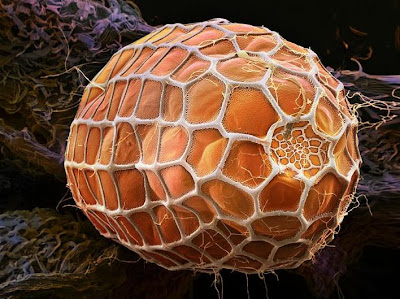We don’t have to look far to find alien-looking lifeforms, as the September 2010 issue of National Geographic shows. All you need is a microscope and a few butterfly eggs. These photos are by Martin Oeggerli in cooperation with Prüftechnik Uri and the School of Applied Sciences, FHNW.
The eggs in these pictures range in diameter from 0.7 to 2 millimeters. The images were made with a scanning electron microscope, which uses beams of electrons to trace the surfaces of objects. The resulting black-and-white images were then colored to reflect the eggs’ natural appearance. I think you'll agree that the result is breathtaking:
Zebra longwing butterfly (Heliconius charithonia) - The orange hue of this zebra longwing butterfly egg may warn predators: "Eat me if you dare." The threat would not be idle. The egg contains cyanide and other toxins ingested by adults from the plants they eat.
Adonis blue butterfly (Lysandra bellargus) - The Adonis blue butterfly is rare because it's choosy. It lays its eggs (like the one above) only on horseshoe vetch, a European perennial. What's more, it looks for patches cropped by rabbits that allow easy landing.
Large white butterfly (Pieris brassicae) - The yellow eggs of the large white butterfly are laid in clumps on the undersides of cabbage leaves (above) and brussels sprouts.
Blue morpho butterfly (Morpho peleides) - The red band signals a chemical reaction that follows fertilization. Inside the egg is the germ of a blue morpho, one of the world's largest butterflies, with a wingspan of five to eight inches.
Owl butterfly (Caligo memnon) - The mosaic pattern on an owl butterfly egg looks like a landing pad. At the center is a minute opening, called a micropyle, through which the sperm enters the egg.






No comments:
Post a Comment